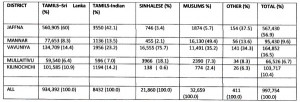By Dr.Rajasingham Narendran
I have been concerned by the claims of some politicians, journalists, NGOs and INGOs about post-war developments of an adverse nature relating to purported settlement of Sinhalese in the Northern Province, contrary to what I could see and gather from the people living within the province.
Table 1 : Population Statistics for the Northern Province (1881-2011)-(Source: Department of Census & Statistics, Sri Lanka)
Northern Province: Includes the districts of Jaffna, Mannar, Vavuniya, Mullaitivu and Kilinochchi)- Please note: The census figures for 2011, do not include the armed forces and police.
The special survey of the Northern Province conducted by the Department of Census and Statistics in the Northern Province in 2011 and the results of previous census carried out since 1881, were a valuable statistical base to find the facts and disprove the fallacies.
The following tables were compiled to highlight facts on a historical and current basis:
Area information: From Wikipedia
Table 1, clearly shows the Tamil (Sri Lankan + Indian origin) population has marginally declined by 169,000- 15.2 %, in the Northern Province in 2011, from the maximum number ever recorded in 1981 (1,112,425). This decrease is much less than I expected considering the war toll and the extensive migration from the Northern Province. In contrast the Muslim population has declined by 39.7% and Sinhalese population by 44.7% from the maximum figure recorded at previous census.
The expulsion of Muslims from the north by the LTTE would explain the decline in the Muslim population. The decline in the Sinhala population is understandable, but is complicated by doubts whether in previous census, the armed force and police numbers were counted. In the 2011 special census, they were not counted. It is also interesting that the overall population of the Northern Province has declined by only 205,355 (17%) from its maximum. This is much less than I had expected. A greater population decline due to the war has been probably masked by the natural increase (births).
Table 2: Detailed population statistics for the different districts in the Northern Province (2011 Census) – (Source: Department of Census & Statistics, Sri Lanka)
Table 2, shows the Jaffna district yet holds the largest share of the Tamil population among the five districts. The Sinhala population is largely concentrated in Vavuniya (16,655). Due to the creation of Weli Oya from Manal Aru in the 1980-1990 periods, the second large population of Sinhalese are in the Mullaitivu district (3966). This is a very small, but concentrated presence in South Mullaitivu.
Table 2, also shows the heaviest concentration of Muslims in the Northern Province are in Mannar and Vavuniya. In other areas, their presence is marginal yet.
Table 3: Northern Province districts by area and population density – (based on 2011 census)
Table 3, shows that the Jaffna district has the highest population density (Persons/ Sq. Km). The other four districts are yet very sparsely populated. The population figures for some districts in the South (2001 census), are as follows: Colombo-3330, Gampaha – 1539, Kalutara -677, Kandy -667, Anuradhapura – 112 and Badulla -276. The lowest population density in the south is in the Moneragala district-72. The 2011 special census reveals that the Mullaitivu district holds the record now with only 25.24, with Mannar having a slightly higher density of 47.8. The Jaffna district is closer to Kalutara and Kandy.
These figures show that there is no concerted effort yet discernible about attempts at demographic changes in the post-war circumstances in the Northern Province by the GOSL. Further, it shows the Mannar, Vavuniya, Mullaitivu and Kilinochchi districts are severely under populated and lack the human resource base, though having the land and other resources to develop a thriving agro-industry.
Jaffna district is yet densely populated in relation to its land and water resources . A part of the Jaffna district population should move into the Vanni and should be encouraged to do so. Jaffna district should become the light to medium industry hub of the north and develop centres of excellence in the educational, vocational training and cultural fields. Jaffna has to be more cosmopolitan in its composition and outlook, to meet the needs, attitudes and skills of the 21st century. This would imply that demographic changes are necessary and be welcome.
To conclude, the politicians, journalists, NGOS, INGOS and the international community should study facts before jumping to conclusions. Canards will not take us anywhere. The presence of the army- which is of course largely Sinhala at present- should not be confused with deliberate attempts at demographic manipulations and used to confound an environment yet prone to unwarranted suspicions and fears.
The wars and their aftermath have not caused an extensive decline in the population of the north, despite the deaths and internal and external migrations. I wonder whether most of the LTTE- related deaths were of cadres from the east and the so-called Indian Tamils secreted into the Vanni by the LTTE. There has been also a migration from the Vanni districts into the Jaffna district.
I felt there were a higher percentage of Tamils of Indian origin in the Chettikulam IDP camps- at least 20% +. This perception is not matched by the census. Where are these people now? The on-going national census may reveal further facts and the post-war demographic realities in the whole country.
The TNA and other Tamil politicians should be careful in what they utter to the Tamils and proclaim to the outside world. They should be extremely responsible in what they say and do. They owe it to their war-affected constituency and to Sri Lanka. To spite the face, we should not cut our nose! Our –Tamil- recovery should be built on facts, not fallacy.



